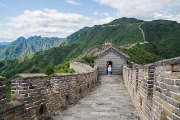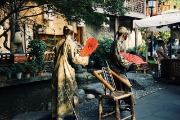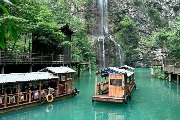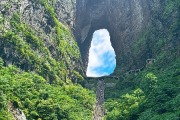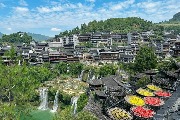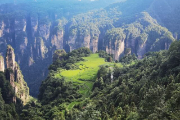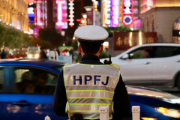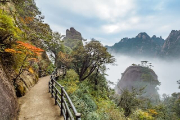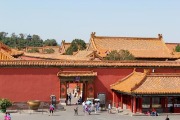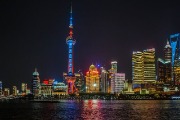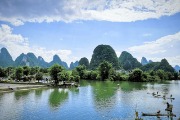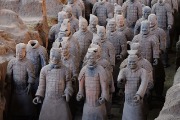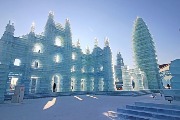Furong Ancient Town
It’s famous across social media for its massive waterfall. The whole ancient town is built around this beautiful cascade.
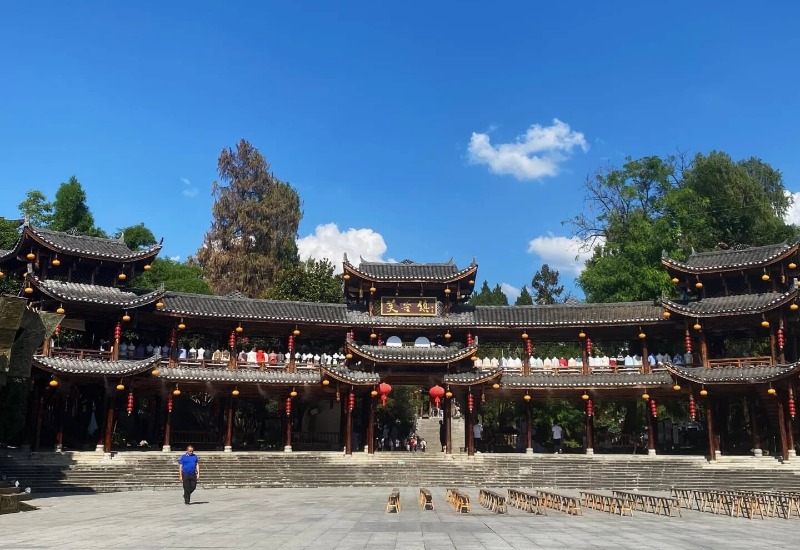
Furong Ancient Town (芙蓉古镇), with a history spanning two thousand years, was originally called Wang Village. It gained fame across China after the film “Furong Town” was shot there, leading to its current name. Surrounded by water on three sides, the town’s standout feature is a large waterfall that flows right through it, earning it the nickname “the thousand-year-old town hanging on a waterfall.” The town preserves its rich Tujia ethnic culture with well-preserved cobblestone streets, traditional stilt houses, and stone paths.
Besides its stunning scenery, visitors can also indulge in local Hunan delicacies like rice tofu, Tujia cured meat, bamboo tube rice, and wild mushroom soup. Additionally, Furong offers a variety of nighttime cultural and entertainment options, including guesthouses, shops, and tea houses, making for an unforgettable evening in the town.
Table of Contents
Scenery of Furong Ancient Town
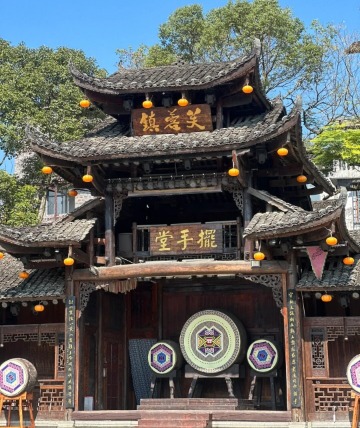
Baishou Hall
Baishou Hall is a crucial site for the Tujia people, used for ancestor worship and major festival celebrations. Constructed entirely of wood, it features red pillars, black tiles, upturned eaves, blue-tiled wooden walls, and intricately carved window frames, exuding an ancient and solemn charm. At night, Baishou Hall is illuminated with brilliant golden lights, making it a perfect spot for taking photos with an ancient Chinese aesthetic. Additionally, Baishou Hall hosts large events at specific times, allowing visitors to partake in traditional Tujia songs, dances, and cultural activities.
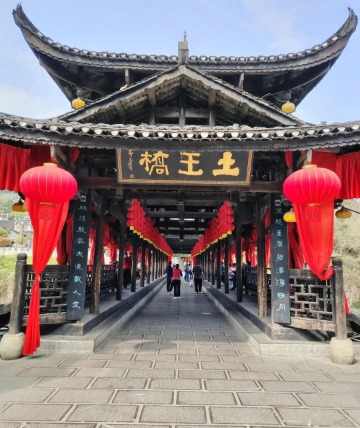
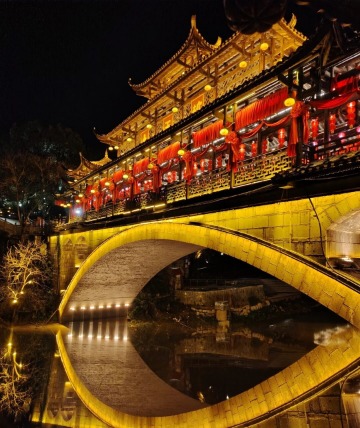
Tuwang Bridge
Tuwang Bridge, located at the entrance to Furong Ancient Town, is a five-arch stone bridge. It features a wooden corridor on its deck, walking across which feels like stepping back into ancient China. From Tuwang Bridge, you can also capture stunning views of the nearby stilt houses and the beautiful surrounding scenery.
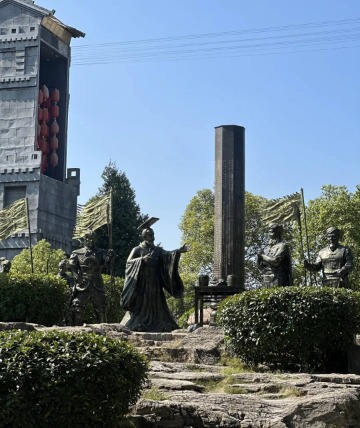

Copper Pillar Garden
Copper Pillar Garden is located at the entrance plaza of Furong Ancient Town, with the original Xizhou Copper Pillar preserved inside the Xizhou Copper Pillar Museum in town. The Xizhou Copper Pillar is a significant marker for the boundaries between the Tujia and Han ethnic groups, symbolizing their peaceful coexistence.

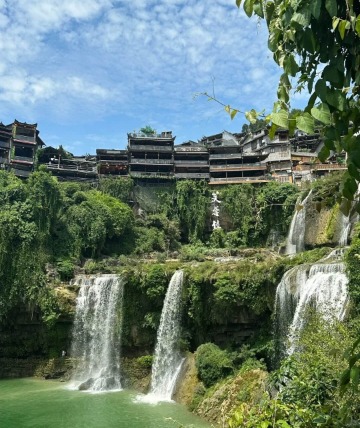
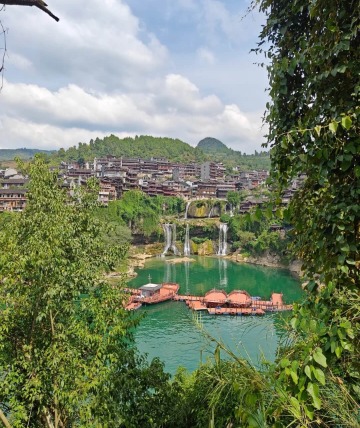
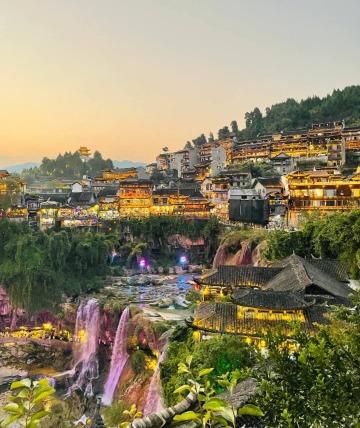
Furong Waterfall
The Furong Waterfall is the most iconic attraction of Furong Ancient Town China. At night, under the glow of various lights, the steadiness of the mountains and the liveliness of the water blend masterfully, transforming the entire valley into a flowing landscape painting. Many visitors come here to snap photos. The waterfall, about 60 meters high and 40 meters wide, cascades down the cliff in two tiers. The sound is thunderous and can be deafening. During the rainy season, the waterfall is even more spectacular, with its roar heard miles away. The mist generated by the falls spreads far and wide, offering a natural air conditioning effect. You can enjoy the view from a stilt house built right on the cliff edge next to the waterfall.
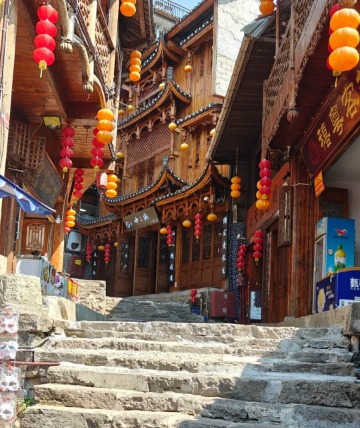
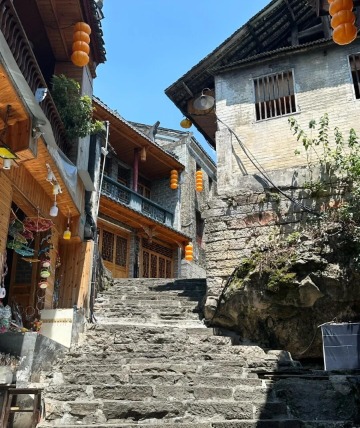
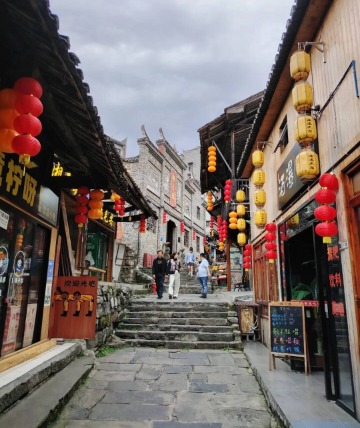
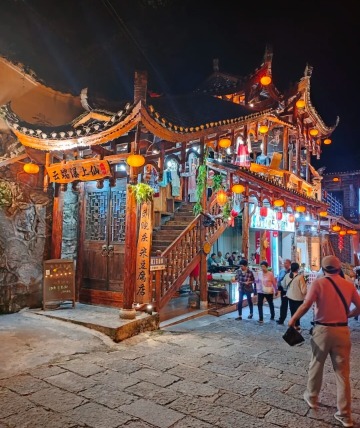
Stone Street
Furong Ancient Town‘s Stone Street stretches for 2.5 kilometers and was built during the Qing Dynasty, maintaining its original condition to this day. Flanked by traditional Chinese wooden structures and Tujia stilt houses, the architecture here has a unique and rustic charm. Along Stone Street, many small shops sell local Hunan handicrafts and souvenirs, as well as a variety of authentic local dishes. You can find specialties such as rice tofu, blood rice duck, and sour soup fish, which are all characteristic of Western Hunan cuisine.
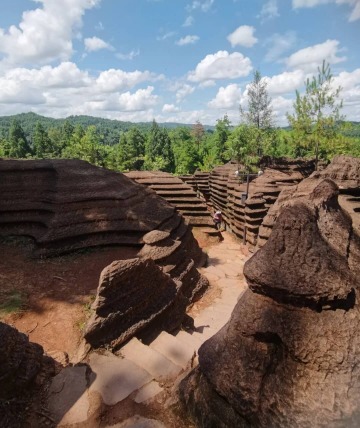
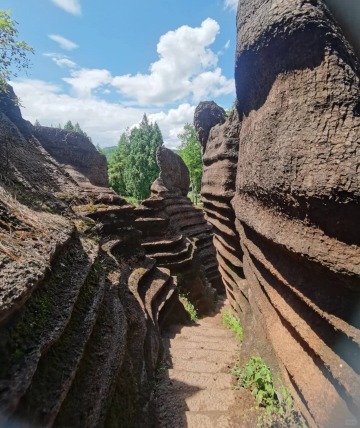
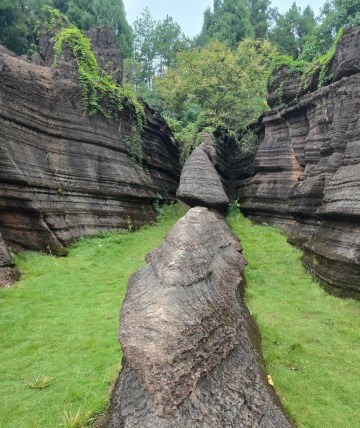
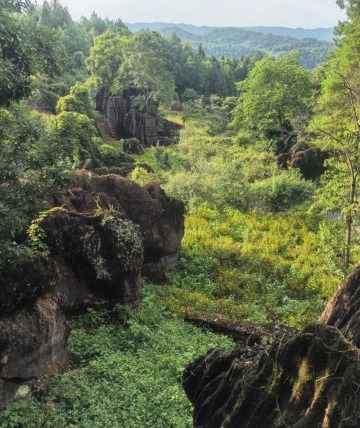
Red Stone Forest
Just over 12 miles from Furong Ancient Town lies the Red Stone Forest, the only Cambrian-period red carbonate rock forest in the world. The formation of the Red Stone Forest dates back about 500 million years, when massive amounts of mixed silt and carbonate materials were deposited on the ocean floor. Over millennia, through tectonic movements and erosion, this stunning geological marvel took shape. The color of the Red Stone Forest changes with the weather: it’s purplish-red on sunny days, turns brownish-red after rain, and reverts to purplish-red when the skies clear again. This dynamic color shift adds to the charm of the Red Stone Forest.
Performances in Furong Ancient Town
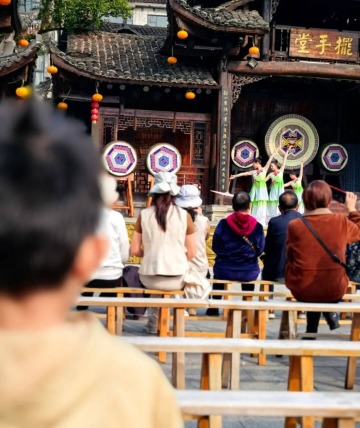

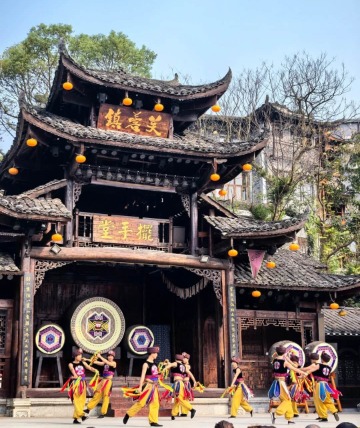
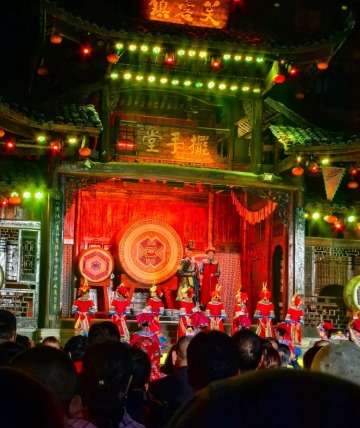
Blossoming Furong: Bizka's Carnival
“Blossoming Furong: Bizka’s Carnival” is a large-scale original immersive live performance in Furong Ancient Town, set against the rich and splendid historical culture of the Tujia people. The show uses an immersive interactive experience, allowing the audience to engage with the plot and feel the emotions of the characters. Viewers can even take on roles within the performance, such as the bride in a sedan chair or the groom in a wedding procession. The performance takes place across various scenic spots in Furong Town, including Baishou Hall, Copper Pillar Garden, Tuwang Bridge, and Yinan Plaza.
Specialty Products of Furong Ancient Town
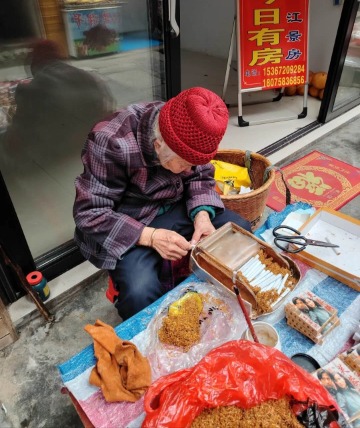
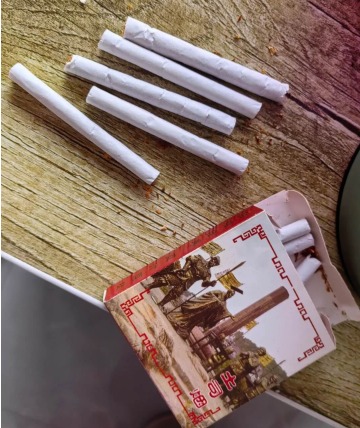
Hand-rolled Cigarettes
Bandit cigarettes are hand-rolled from homemade tobacco by residents of Furong Ancient Town. Local elders are accustomed to smoking these, although they are prohibited from the Chinese tobacco market. An elderly woman, over eighty years old, crafts these cigarettes at her doorstep, selling them to both locals and tourists. They are quite affordable, so if you’ve never tried hand-rolled cigarettes, this could be an interesting experience. However, keep in mind that smoking is detrimental to health, so it’s best to indulge minimally.
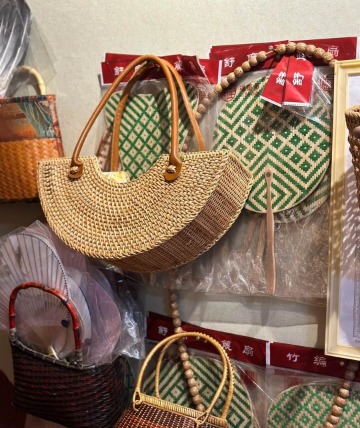
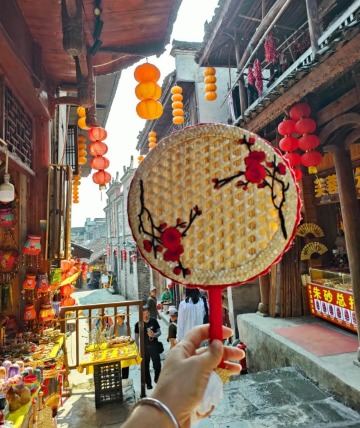

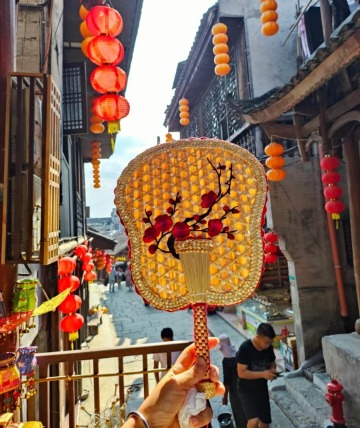
Bamboo Weaving
Bamboo weaving has a long history in China, dating back to the Neolithic Age. Furong Ancient Town offers a wide variety of bamboo products, from everyday rural items like small backpack baskets and fish baskets, to urban uses like fruit trays, vases, cup holders, and carrying baskets—over 20 different types. These bamboo crafts are not only practical but also aesthetically pleasing and are exported to countries like Japan, South Korea, and the USA. You can buy your favorite bamboo handicrafts in Furong Town or even learn how to weave your own under the guidance of a master weaver.
Furong Ancient Town Hotel
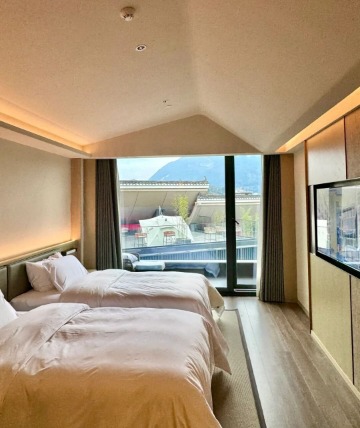
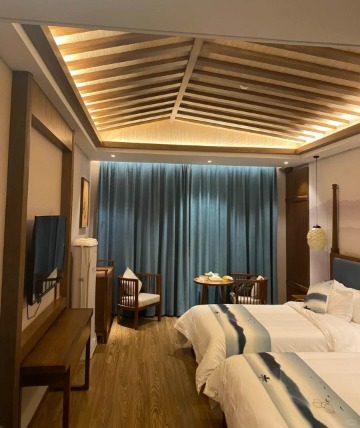
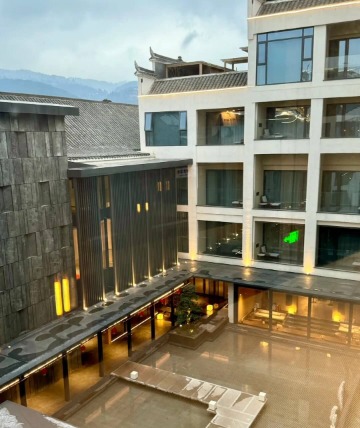
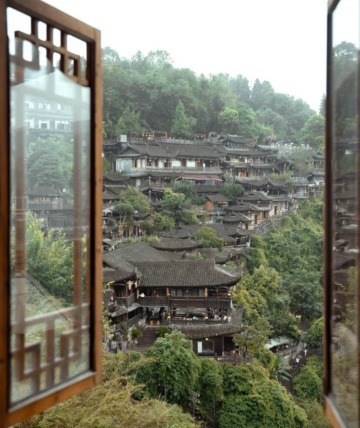
Furong Ancient Town offers a wide range of hotel options, from modern to rooms styled in traditional Chinese architecture. Most accommodations in the town feature solid wood interiors, and opening your window reveals stunning views of the waterfall. Many hotels also house Chinese restaurants that offer room service. You can enjoy your dinner on the balcony while taking in the breathtaking nighttime view of the waterfall.
FAQ About Furong Ancient Town
1. How long to stay in Furong Ancient Town?
A visit to Furong Town is typically enjoyable for about 3-4 hours. If you’re also interested in exploring nearby attractions, you might want to plan a full day’s itinerary to include places like the Red Stone Forest and Buniemen.
2. How do l get from Zhangjiajie to furong?
To get from Zhangjiajie to Furong, you can take a high-speed train directly to “Furong Town Station.” From there, it’s a quick 5-10 minute taxi ride to the scenic area. Alternatively, you can take a bus from Zhangjiajie Central Bus Station to Furong Town. There are frequent departures; the first bus leaves at 7:30 AM and might depart earlier if it’s full. The journey takes about an hour and a half and costs around 40 yuan.
3. Is there a train from Furong town to Fenghuang?
Currently, there’s no direct train from Furong Ancient Town to Fenghuang Ancient Town. The main ways to travel between these two places are by long-distance bus or private car service. The bus is a more economical and convenient option, with a journey time of about 2 to 3 hours, and it’s relatively inexpensive. Once you arrive in Fenghuang, the bus station is centrally located, making it easy for visitors to walk or take local transport to their hotel or tourist spots.
4. Which is better Fenghuang or Furong?
I’d recommend Fenghuang Ancient Town over Furong. Furong’s attractions can be covered in about 3-4 hours, and its main waterfall is more impressive at night when lit up; during the day, it’s pretty ordinary. Plus, during dry seasons, the waterfall’s flow decreases, diminishing the impact. Fenghuang, on the other hand, is great for an overnight stay. It has more to see and a livelier nightlife.
Hours & Fees
Hours
Open daily from 7:30 AM to 11 PM.
Best Time
Spring (March to May) and Fall (September to November). Note: The waterfall in Furong Town is fullest from June to August.
Fees
108 CNY per person (about $15 USD), includes the “Blooming Furong – Bizka’s Carnival” show.
How Do Local Visitors Rate the Furong Ancient Town?

Translation:
Furong Ancient Town has really gained a lot of attention in recent years. I’ve seen it featured on all kinds of social media platforms. Most of the buildings are made of wood, and the small streets are paved with old bluestone slabs. When I went out around 1 PM—the hottest part of the day—the town was fairly quiet. There are lots of shops and restaurants along the way, but the sun was intense, so I stuck to walking in the shade. By 5:30 PM, the lights started to come on. The waterfall looked beautiful under the warm glow of the lights—absolutely captivating. The town doesn’t feel overly commercialized, which makes it a pleasant experience. You can even rent traditional Miao clothing, and the great part is you can return it later in the evening. As for the food, just my two cents: the rice tofu is okay to try once, but it’s not a standout. The rice noodles, though, are pretty tasty!

Translation:
The night view of Furong Ancient Town is truly beautiful. Even though it’s also an ancient town, it feels completely different from Fenghuang Ancient Town—it’s much less commercialized! The scenery is genuinely stunning, though the performances are just average. Whether you watch them or not doesn’t really matter. This place has a unique kind of beauty that you can only fully appreciate by visiting in person. The only downside is that the whole town isn’t very big—you can explore it all in about three hours. There are bars nearby where you can spend your evening listening to music, sipping on a beer, and enjoying the breathtaking view of the waterfall. It’s such a relaxing vibe!

Translation:
The waterfall is really beautiful, but to be honest, the town itself is quite small, and the waterfall is the only truly noteworthy sight. It does look better at night when the lights are on compared to during the day. Other than that, there’s not much that stands out. The restaurants around the town are pretty average. If you walk a bit further out, you’ll find much better food options. On the bright side, the inn we stayed at was clean and cozy, with a nice, welcoming vibe.
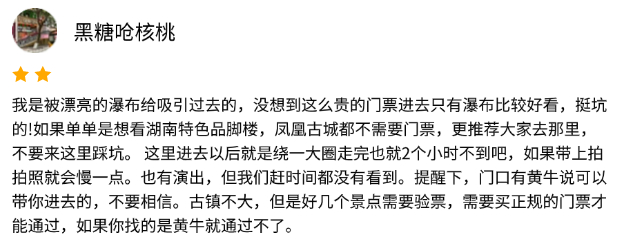
Translation:
I was drawn to Furong Ancient Town by the beautiful waterfall, but honestly, the pricey ticket was a letdown—it’s really just the waterfall that’s worth seeing. Felt like a bit of a scam! If you’re mainly interested in seeing traditional stilted buildings in Hunan, I’d recommend going to Fenghuang Ancient Town instead. It’s free to enter and a much better experience—don’t waste your time and money here. Once inside, you basically just walk a big loop, which takes less than two hours, unless you stop often for photos. There are some performances too, but we were in a rush and didn’t watch them. One thing to watch out for: there are scalpers at the entrance claiming they can get you in without a ticket. Don’t believe them. The town is small, but there are several spots where tickets are checked, so only official tickets will work.


